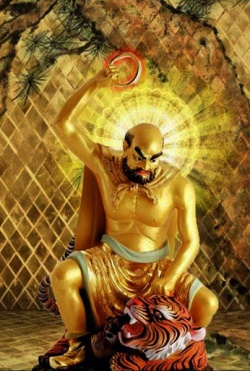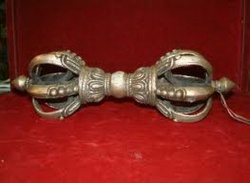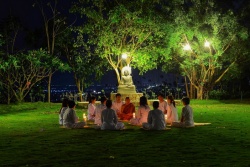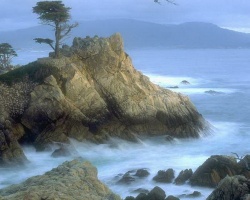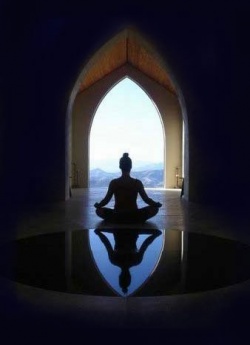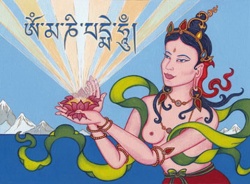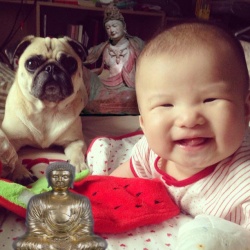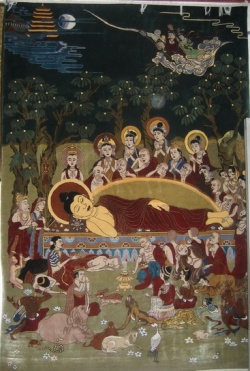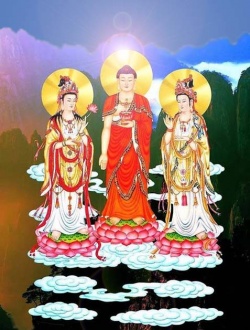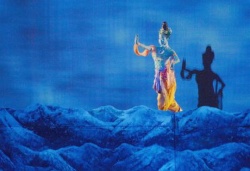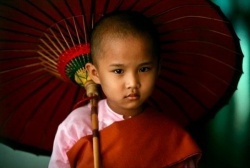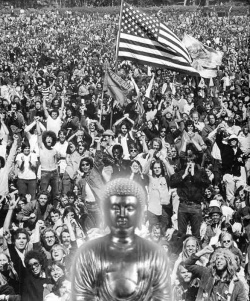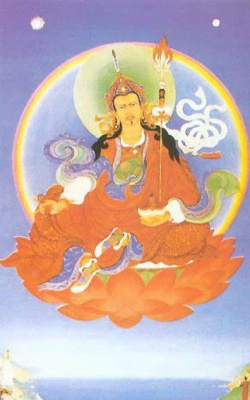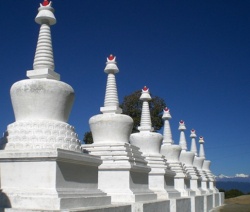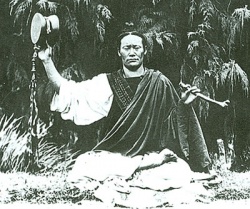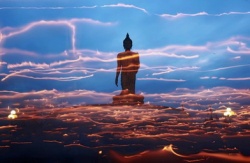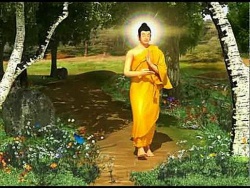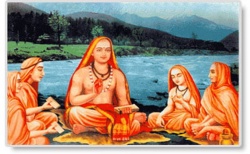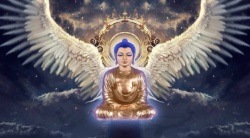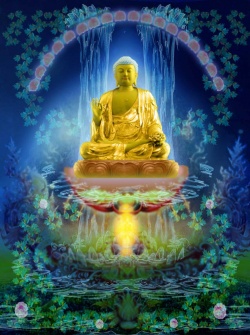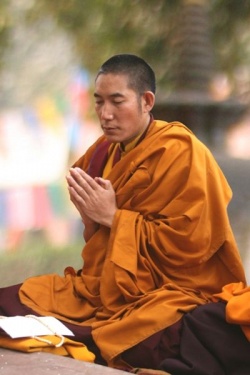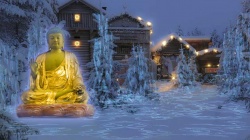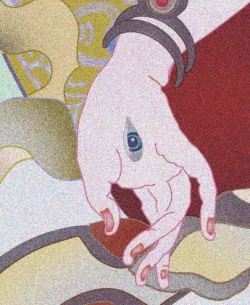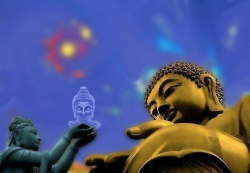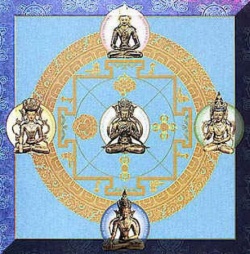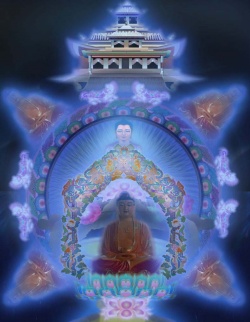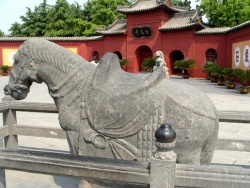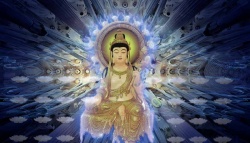A Little About Stupas
by Dr. Garrey Foulkes
Some 35 years ago at a monastery in Nepal a German man asked me if I could help him build a thing called a stupa on the top of a small hill. I knew nothing about stupas but had time on my hands and some building skills so I agreed to do this.
After we had finished the foundations we went down one morning to find that all of the bricks had been stolen so we got no further and I continued with my travels, albeit with some strange feeling that there was something a little uncomfortable about abandoning this task; that some connection had been made and it was not being fulfilled.
About ten years later I was living with my young family in a Buddhist centre in Queensland when our teacher, Lama Thubten Yeshe passed away and the request came through that we should build a stupa in his memory.
This was to become the first major Tibetan-style stupa built in Australia and quite possibly the Southern hemisphere and it was to be the beginning of a long and wonderfully fortunate journey that has kept me busily involved with stupas to this day.
Why I mention this lies in the interest I have relating to why did this all come about?
What was it that made something so alien to a young Western traveller have such an effect on the whole of the rest of one’s life? Of course, as time went by, and more and more research was done into the meaning of stupas,
it began to come clearer that these structures, that represent the fully enlightened mind of the Buddha, have immense power to influence our lives. It is said that every single sentient being that comes into contact with a stupa will benefit:
it is like a subtle seed being planted in the mind- stream of those beings and sometime in the future, when the circumstances are right for that seed to develop, our minds will meet with conditions that give us the opportunity to connect with and follow the teachings of the Buddha in accordance to our pre- determined Karma.Maybe it was like this for me?
Maybe I just got lucky?, or maybe, as I’m sure at least some of my friends think, I’m just another nutty person wasting my life building strange objects.
Given that I have been kindly asked to be a part of this important event and to say something about stupas I feel it would be helpful to give a very brief account about the symbolism and general meaning of these amazing buildings. Of course the subject is vast, covering many centuries of development;
from simple mounds of earth all the way up to the great and elaborate stupas of Borobudur, Svayambhunath, Bodhnath, Gyantse and those throughout S.E. Asia.
Countless others, ancient and modern, ruined and still standing, stretch from Afghanistan to Japan and more recently, with the spread of Dharma teachings, into almost all Western countries.
Even in my own country Australia there are at least twenty large stupas including a same- size replica of the Great stupa of Gyantse which is rapidly nearing completion.
Stupa is a Sanskrit word meaning “to heap” or “to pile” and refers to the mound-like shape of the earliest stupas.
The Mahaparinirvana Sutra tells us that it was he Buddha himself who outlined the basic design for a stupa.
The story begins at Buddha’s deathbed where he gave instructions about the disposition of his body.
He said that his body should be cremated and the relics divided up and enclosed in four different monuments. These were to be erected at:
Lumbini, the place of Buddha’s birth.
Bodhgaya, where the Buddha attained enlightenment under the Bodhi tree.
Sarnath, where he gave his first teachings.
Kushinagar where he passed into parinivana.
His disciples asked what form this monument should take.
The Buddha did not reply but instead gave a practical demonstration. He took his outer yellow robe and folded it in half and in half again until it formed a rough cubic square.
Then he took his begging bowl, which was round, turned it upside down , and placed it on top of the robes.
“Make a stupa like this” he said. So these original instructions, directly from the Buddha, have remained the basic form for all stupas throughout the world.
In addition to the eight great stupas shown in the picture above, two other types of stupas are commonly built in the Tibetan tradition.
These are the Kalachakra stupa built to help establish world peace and the Kadampa stupa built to commemorate the teachings and practices of the Kadam tradition founded by Lama Atisha, who kept a stupa with him at all times to instantly purify even the slightest misdeed
The ten traditional purposes of stupas are:
1. To remind one of a teacher.
2. To act as a reliquary.
3. To magnetise enlightened energy.
4. To speed a teachers rebirth.
5. To promote longevity.
6. To create peace and harmony in society.
7. To magnetise wealth.
8. To turn back invading armies.
9. To subdue physical and mental illness, pestilence, and disease.
10. To actualise enlightenment.
Probably it is safest when giving a description of a stupa that we take as an example what I feel has become established as the “iconic” stupa.
These highly refined stupas are found throughout Tibet, Nepal, Mongolia, India, Ladakh, Sikkim, Bhutan and many other countries.
They are often seen in sets of eight representing “the eight great deeds of the Buddha’s life” symbolising: Birth, Enlightenment, First teachings, Miracles,
Descent from Tushita heaven, Reconcilliation, Long life and Parinirvana (passing away) .
The only significant difference between these eight stupas is what is referred to as the “stepped” section positioned above the throne and below the vase.
The most frequently seen of these stupas is the stupa of Enlightenment celebrating Buddha Shakyamuni’s enlightenment under the Bodhi tree in Bodhgaya.
Before giving a brief description of these stupas it would be prudent to say several things .
First and foremost, I am only a kindergarten student when it comes to talking about stupas.
We should always remember that stupas are an architectural symbol representing the awakened mind of the Buddha and consequently symbolise achievements that most of us can only dream of.
Secondly there are so many variations of stupas, often coming from the same basic plan, so it is important for us not to discriminate, saying “Oh, that one is not right.”
Or “ that one is not as good as ours”, or “what that teacher say’s is not right” etc.
All holy objects, grand or simple, beautiful or a bit rough, our views/their views should all be treated with the same degree of respect.
So, stupas are an architectural symbol of the Buddha’s enlightened mind but they also contain everything we need to know in order to follow that path from our own side whether we are complete beginners or advanced students of Buddhist philosophy.
Each level of a stupa represents different stages of the path.
The sections that runs from the base of the stupa to the first of the steps represents the throne on which the Buddha sits.
Above this and up to the top of the Harmika, just below the first of the 13 rings, represents the body of the Buddha.
The different levels , starting from the base of the stupa and going up to the top of the throne represent:
The ten virtues of body, speech and mind.
The three refuges of Buddha, Dharma (teachings) and Sangha (spiritual teachers) .
The lion throne symbolizes superiority over the entire universe and the eight fearlessnesses.
The treasure vase symbolizes the eight noble riches.
The lotuses represent unlimited love, compassion, joy and equanimity.
Inside the treasure vase of the stupa we first place a double dorje or 4-pointed vajra to offer protection in all of the four directions.
On top of this sits a wealth vase containing as many holy relics as one can obtain, the 5 jewels , 5 precious medicines, the 5 grains, 5 nectars, 5 perfumes and stones, water etc. from holy places and currency from around the world.
These are then sealed in the vase by tying 5-coloured cloths over the opening at the top of the vase.
There can be one, five, or nine wealth vases in the stupa base.
The rest of the space inside the throne is filled with many objects that symbolize the worldly possessions we need to be able to have a comfortable life .
Usually small models are used for this purpose in order to get as many different things in as is possible.
These can be all and everything that represent food, warmth and shelter such as bags of grain and other foods, clothing, blankets, household utensils of all sorts, things representing transport such as model planes, cars boats etc. precious cloths and brocades, fragrant substances, medicinal herbs, different metals,
fertile soil , weapons (symbolizing protection from harm) earth from the property of wealthy people, nuts and dried fruit, pure water, many mantra’s rolled in yellow cloth, and selected small statues .
Any remaining spaces are packed with powdered sandal wood or other types of incense before the throne is sealed.
These offerings placed inside the throne are not done so with the desire for us to become wealthy for wealth’s sake but more as a request enabling us, in the future, to be sufficiently comfortable to be free to spend our whole lives studying the Dharma without having to worry about pursuing worldly activities
The next four stepped levels symbolize the four attentions, four perfect efforts, the miraculous feet….prayer, thought, enthusiastic perseverance and action and the five spiritual faculties….
Faith, energy, attention, concentration and knowledge. These four steps correspond with the Buddha’s lower body from the waist down.
The Bumpa vase, or dome, which contains a niche where the Buddha statue sits, represents the celestial mansion of enlightened beings. This level represents the seven branches of awakening:
memory of past lives, perfect knowledge of Dharma, diligence, ecstasy, mastery of all disciplines, perfect effort, perfect attention and perfect concentration. This section corresponds to the Buddha’s torso and upper body.
On the side of the stupa that faces to the East there is a niche where a statue of Shakyamuni Buddha is placed.
The outer face of the niche is surrounded by the Ghokam -frame which is often richly decorated with symbolic animals, goddesses, and protectors.
The Harmika that sits directly above the vase corresponds to the position of the Buddha’s head and represents the eight superior paths of perfect view, perfect understanding, perfect speech, perfect action ,perfect living, perfect effort, perfect attention and perfect concentration.
At this point many stupas have the “all-seeing” wisdom eyes of the Buddha painted on all four sides of the stupa. This is not usually done on any of the eight great stupas.
Above the harmika is the life channel that has thirteen rings representing the ten powers of attainment and the three essential mindfulnesses of the Buddha.
Above these thirteen rings is the parasol or umbrella symbolizing the great compassion- mind of the victorious one, offering help and protection to all.
The sun, that radiates a thousand lights of compassion, represents intention to bring all beings out of suffering and into the bliss of enlightenment.
The moon symbolizes conventional bodhichitta and the sun ultimate bodhichitta.
On top of the sun and moon is a jewel representing the final result of enlightenment and Buddhahood.
Many stupas have two garlands of lotus flowers coming from below the umbrella to the top of the bumpa vase.
These symbolize Great wisdom and Great compassion, perfectly balanced, like the wings of a bird.
So on the basis of such a foundation, free of the ten non-virtues, one trains in the path and finally attains enlightenment
These stupas also represent the four elements as well as space.
The throne part of the stupa represents the Earth element (yellow), the chest or vase is water (white), the thirteen rings are fire (red) the pole of the umbrella is wind (green) and the umbrella itself corresponds to space (blue).
So hopefully this helps give a little insight into what we are confronted with when we look at the external form of the stupa and just why these extraordinary structures can have such a profound effect on our minds.
The internal sections of the stupa above the throne or treasure vase, as mentioned, correspond to the body of the Buddha seated on the throne and contain a vast amount of material related to the Buddhas holy speech and holy body.
Running from the top of the throne to the inside of the thirteenth ring at the centre of the stupa is the sok shing or life-tree representing the ten knowledges.
This is made from a living tree which, after a ritual asking permission from the spirits to cut that tree, is marked on the side facing to the East.
The tree needs to be of good smelling and not poisonous wood .
The timber needs to be dried and then shaped into a long tapering pole always keeping the East side marked.
The pole is then painted red, has a double vajra carved at the bottom and a tiny Namgyalma (long-life) stupa carved at the top.
The five chakra points are then painted in gold with OM at the position of the crown, AH at the position of the throat, HUM at the heart, TRAM at the navel and HRIH at the lower chakra point.
Mantras are then painted below the syllables before the sok shing is wrapped in yellow cloth. Once this is done two different grasses are attached to the North and South sides of the tree and are held in position with five coloured threads twisted together.
The sok shing represents the central channel and the grasses the left and right channels that control our breathing and are a major source of visualisation and concentration for practitioners of meditation and advanced Yoga.
The remaining spaces are filled mainly with different texts that symbolize the Buddha’s speech, rolls of mantras and many thousands of small clay or plaster images of different deities representing the Buddha’s body.
Where the similarities between these iconic stupas and other forms of stupa designs tends to relate more closely is at the point when we start to look at what goes inside the stupa from this level above the throne.
We have seen, through looking at the external symbolism of the stupa, that the different levels represent different stages of the path to enlightenment .
All of these stages of our learning and development on what is called the “graduated path” correspond to certain teachings we take, meditations we perform and the different deities and visualisations that relate to these practices.
So with the stupa we have been discussing, these texts and deities are within the stupa whereas stupas like Borobudur have these images carved in relief on the outer face of the stupa and in the case of the Gyantse stupa the deities are in a series of some 75 chapels within the stupa.
Larger stupas usually contain the Kangyur and Tangur texts - two large and extensive volumes, the first containing the 84,000 teachings of the Buddha and the other a commentary on those teachings.
So, whatever our practice, it will relate back to those teachings. Mantras and deity visualization help us to connect with certain energies relating to our body, speech and mind.
Deities are there to help us develop our minds through visualisation so we can understand more clearly our own nature.
We try to develop good, positive energy and eliminate harmful or useless energy.
There are both peaceful and wrathful deities to help us develop wisdom, a kind heart, compassion etc. and eliminate desire, indifference, aversion etc.
Deities placed inside stupas usually come in the form of small statues called tsa tsa’s made from pressing clay or pouring plaster into a mould.
Many thousands of these are then placed in the appropriate position of the stupa along with mantra rolls that also correspond with different levels of the stupa.
There are at least 27 important mantras that need to be included. Every possible tiny space is then filled with powdered incense before being sealed.
The final stages are the external decorations, these can be quite different from one stupa to another but generally we see eight Snow lions supporting the four corners of the throne, 3 or 4 rows of lotus petals, and extensive decorations on all the corners of the stupa.
The Gokham and 13 rings are often painted gold or are gold-plated.
Before any ingredients are placed within the stupa they need to go through an elaborate ritual overseen by qualified monastic practitioners in order to be blessed and purified.
Once all of the filling has been done and the stupa sealed there is another ceremony performed to consecrate the stupa and purify any mistakes or omissions that may have taken place during the construction and filling.
This ceremony can last several hours, a whole day or up to three days depending on the importance of the particular stupa.
The final result of building a holy object such as a stupa is that, once consecrated, it is imbued with all of the qualities that have been described above.
This means that all of the beings in that particular place will receive numerous benefits. They will have a peaceful atmosphere, much harmony and happiness, and good livelihood.
In the same way if we make offerings to a stupa, contributions and donations towards its upkeep etc. we receive great benefit from our acts of both offering and opening the door to developing a generous heart.
The benefits, in the form of merit, are what lead us closer and closer to nurturing and developing a positive mind and eventually reaching the ultimate goal of liberation for the benefit of others.
Prostrating and circumambulating stupas is another very important way of increasing our merit.
A prayer compiled by Kybje Lama Zopa Rinpoche to recite when seeing a stupa:
“ From now until enlightenment may myself and all these sentient beings, those who are working very hard and all others, always be able to find and meet perfect gurus such as Manjushri , Shakyamuni Buddha, Chenrezig, Lama Atisha and Maitreya Buddha.
May all their holy wishes be fulfilled immediately and may we never rise heresy and disrespect”
I felt it was important to choose to give this description of what we may call “a modern day stupa”. Of course most of the essential elements of stupas remain the same but refinements can take place according to the changing times and the way living lineage-holders view the rapidly developing changes in our current world.
We see this very clearly with some of the offerings placed inside the stupas.
Who would have thought,50 or 100 years ago, that one of the world’s biggest problems would be pure drinking water or that there would be everyday things like electricity and all of the appliances it runs, aeroplanes and cars, modern medicine and countless other things that make our lives more comfortable? Many of these have become the “new offerings” placed in the throne section of stupa.
Borobudur and Gyantse
Borobudur stupa has a long and rich history but interestingly enough very little is actually known about what is the world’s largest stupa and certainly one of the oldest.
Much of the early history of this amazing building was recorded on material made from palm leaves which has been lost to the elements over the years.
Thought to be constructed between the 8t hand 9th centuries it remained virtually unknown to much of the so-called civilized world until “discovered” by Thomas Stamford Raffles and a crew of surveyors in 1814.
Up to this point in time most people considered Java to be a remote cultural backwater completely neglected by the great Indian and Chinese civilizations that found their way into many parts of South-East Asia and had such a huge impact on their culture.
Buddhism was practiced in India 1000 years before Borobudur but how it travelled over 5000 kilometres to Java remains a speculative mystery, and what inspired them to build the stupa perhaps an even greater mystery.
What Raffles and his team discovered completely changed their view of Java’s past, unveiling not only what was to prove to be Asia’s greatest artistic achievement, but completely changing the mistaken view that Java was an exclusively Islamic domain.
Clearly this was a Buddhist monument and clearly it had been there for a very long period of time. It follows that there must have a thriving community of Buddhist scholars and devotees.
We now know, through Atisha, and other great scholars who visited Srivijaya to take teachings from the great master Serlingpa in 1013, that this was the case.
Many Buddhist pilgrims also took the long and hazardous journey to Java as its reputation as a great centre of learning grew. Atisha himself remained for 20 years before being invited to Tibet where he was to have such a huge influence on Tibetan Buddhism.
Borobudur was built, under the instructions King Samaratungga several centuries before Angkor Wat and almost 500 years before the great cathedrals of Europe.
Constructed using over one million large stones, all weighing around 100 kilograms, all shaped by hand, with over 1,400 carved images on the walls illustrating the five Buddhist texts , 1200 decorative reliefs,500 Buddha carvings and 24 elaborately decorated gateways.
All of this carried from a river-bed below the stupa site and placed into position, covering an area approximately 65 meters square and 34.5 meters high. This surely has to be seen as one of the truly great buildings in all of history.
Little wonder the first Westerners to view this building were stunned and, thanks to common sense, it was decided in 1974, (a time when I was fortunate enough to visit) that a major renovation should be undertaken, covering almost ten years and costing many millions of dollars. Borobudur was eventually returned to something like its former glory.
This great monument now has UNESCO World Heritage status.
It is believed that the temple in the early days of its history was rendered with plaster and painted white.
We can only imagine how spectacular this would have looked amid an emerald green jungle setting.
Like most stupas Borobudur’s overall form represents a combination of mountain and mandala. The mountain represents mount Meru that sits at the centre of the Buddhist universe.
The mandala, of concentric squares and circles, surrounds this and represents the seven continents and oceans. The great stupa of Gyantse follows along very similar lines.
Borobudur has nine ascending terraces; the six lower terraces are in square form and the three upper terraces in concentric circles.
Mandalas are very elaborate works of traditional Buddhist art usually painted onto canvas but often intricately drawn with many coloured sand grains for important initiations and the like.
Each mandala, drawn in plan form, represents a different deity and at the centre of the mandala is the seed-syllable for that specific deity. They are seen as celestial palaces where the Buddha’s abide.
If we treat the mandala drawing as a plan for a building and wish to turn it into a 3-dimensional form then the various levels of the mandala drawing are stood on their sides (the same way as an elevation drawing for a house plan) creating an elaborate Mandala house, richly decorated on the outside with artwork,
lotus petals, protectors, offering goddesses , garlands of jewels, and the like. Stupas, taking on the form of colossal mandalas, retain all of these characteristics.
This perhaps gives a good insight into the strong likelihood that at some stage Borobudur stupa was indeed beautifully painted and decorated.
It is generally believed that Borobudur stupa was designed to invoke the most important mandala in Tantric Buddhism , the Vajradhatu or diamond mandala at the centre of which is seated, at the very top of both the mandala and mountain, Mahavairochana, the “Illuminator”, who generates enlightenment for all.
The Buddhist pilgrims and devotees consequently were able to ascend the stupa while circumambulating all of the different levels of the stupa.
Moving from the world of desire and attachment on the lower levels, up through the various stages of the path; all beautifully carved with images symbolizing life in the different realms and finally, by following a series of specifically placed passageways, to the uppermost level eventually arriving at the world of formlessness.
In other words, the long journey from deep ignorance to full awakening.
On the upper level there are 72 bell-shaped stupas housing life-sized images of the Buddha looking out from the monument through a series of grids carved into the bell. A further 108 carved images of the Buddha are placed in niches on the four sides along the lower terraces of the stupa. It would have been a long journey for pilgrims ascending this mighty stupa and taking in the deep significance of every image.
Unfortunately these days most visitors are not Buddhist pilgrims but tourists so let us hope that the power of this wonderful Buddhist monument will help sow the seeds for future good -fortune in the minds of all who visit and the stupa continues in some small way to serve its purpose.
THE Gyantse Kumbum
If we look at the two ground-plan drawings above they clearly show the similarities between these two great stupas, both closely following the same mandala plan, with Borobudur having nine levels and Gyantse five.
Gyantse stupa, built in the mid-15th.century is constructed around a huge rock pinnacle with the various shrine rooms positioned between the outer face of the walls and the rock. Perhaps this design has enabled the stupa to last for around 500 years without significant damage like we have seen with Borobudur.
Even though constructed largely from earth and small stones, there is little doubt that a climate far more gentle than the tropics, along with constant care from generations of Buddhist practitioners, have helped with longevity.
Fortunately this amazing stupa managed to survive the Chinese occupation of Tibet; almost all of the surrounding buildings and many stupas in other areas were razed and many statues of value were stolen or vandalised.
Probably the stupa survived because the Chinese government realised its tourist potential leading to some of the damaged statues being repaired and repainted; unfortunately in such a crude manner that much of their former beauty has been lost.
Like Borobudur the different levels of the stupa lead us up a series of stairways and passages where similar images to Borobudur but, rather than being carved on the outer walls, are represented within the 75 different shrine rooms.
The outer walls are finished more simply with the 8 auspicious symbols and other traditional decorations.
Gyantze Kumbum (100,000 Buddha images) is a Tashi Gomag stupa which celebrates the Buddha’s “first turning of the wheel”; often referred to as “the stupa of many doors” or “first teachings”
This is the third in the series of the eight great stupas and follows on from the Enlightenment stupa.
In brief the many doors represent the many different ways that the Buddha instructed his disciples according to their own development and understanding.
As with the Borobudur stupa the higher we rise while circumambulating the stupa the more profound the teaching becomes.
Within the shrine rooms there are large numbers of sculptured statues and the walls are beautifully painted by the great artists of that time. These statues and artworks represent all of the different Tantra’s and their precise arrangement.
At the level of the Bumpa vase are four large doorways.
The south-facing door leads into a room that houses a statue of the historical Buddha and celebrates the spread of the Dharma teachings.
The Northern temple celebrates the teaching of the former Buddha who taught in previous aeons.
The Eastern temple has a statue of Maitreya, the Buddha of the future.
In the Western chapel is the Buddha Amitaba who teaches in the pure-land.
Above these are the sok-shing that runs up through the 13 rings and supports the huge parasol.
The 13 rings on the spire along with the parasol are gold plated as final offering to this amazing building elevated above the main street of one of Tibet’s major spiritual centres.
Before finishing I should mention The Great Stupa of Universal Compassion being constructed in Bendigo over the past 15 years.
Named by His Holiness the Dalai Lama and designed to last at least 1000 years, the idea for this stupa was suggested some 20 years ago by Lama Thubten Yeshe and the plan was put into progress by his disciple Kybje Lama Zopa Rinpoche.
The “Great stupa” is to be an exact external replica of the Gyantse Kumbum. So this stands as a perfect example of how the long and rich lineage of the Buddhist teachings, statues and stupas are still with us to this day; passed down from the great historical teachers over thousands of years.
These great scholars and practitioners are still among us, spreading the Dharma teachings and continuing the lineage, constantly offering us the opportunity to attain the ultimate goal of Enlightenment.
The Great stupa at Bendigo is now well advanced and, interestingly, is located beside a Buddhist college named “Atisha centre”.
Thank you.
